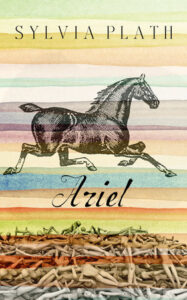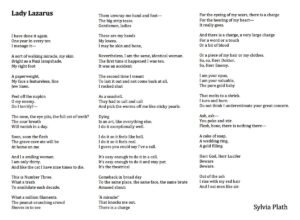Why Shouldn’t Free Ways Be Abandoned to Dead Ends?
Human Dignity and Lady Lazarus
By Zehra Selin Tunca

Lady Lazarus, written by Sylvia Plath, is an allegorical poem originally included in the collection Ariel. In this poem, Plath portrays herself as an image of shattered femininity, but one that is resurrected from her ashes. She draws a correlative line between her personal misery and the Holocaust, the most horrible event in human history. By identifying herself as a suffering victim alongside those who lived in Nazi camps, she positions herself as an equal to the victims of genocide. The speaker of the poem deliberately places herself in a larger, horrific context to showcase her inevitable, oppressed position. She also highlights that her story is not only about herself, but also about other women who suffer under the oppression of patriarchy. By intertwining her suffering with the theme of the Holocaust, she not only elicits sympathy from readers but also conveys the trapped and tortured condition she experiences as her agony intensifies. She equates patriarchy with the Nazi regime, as both systems of oppression were initiated and perpetuated by men.
In her dramatic monologue, Lady Lazarus emerges as a triumphant resurrected goddess, despite being trapped in oppression, hopelessness, and misery. Her failed suicidal attempts create a sense of accomplishment, as she considers them a peculiar skill—the art of dying. She asserts, “Dying is an art, like everything else. I do it exceptionally well.” This implies that in Holocaust camps, the prisoners learned to live in a state of death—an art of enduring pain, fear, and hopelessness. She further suggests that the feeling of death is palpable, and enduring a life of constant pain and struggle feels like hell. She states, “I do it so it feels like hell. I do it so it feels real.” By utilizing material objects associated with the Nazis, which were made from European Jews, such as a Nazi lampshade, a paperweight, and fine Jew linen, she symbolizes her return from death as an inanimate object used by the Nazis. By dehumanizing herself and aligning with these objects, she implies the restricted role of women in a male-dominated world—as mere instruments for satisfying sexual desires, devoid of agency and intellect. Plath employs these symbols to depict her poetry confined to papers, serving as a mere paperweight, while illuminating the male-centric world, leaving her in darkness. The imagery of Jewish skin serves as a bizarre metaphor, symbolizing women’s bodies as sexual objects catering to the needs of men. It highlights the degrading treatment and objectification experienced by women within the patriarchy.
The final lines of the poem contain an allusive stanza: “Out of the ash I rise with my red hair, and I eat men like air.” These lines express a desire for resurrection, to return as a female avenger who inflicts pain and discomfort, shaking the self-confidence of men. The phrase “eating men” also alludes to cannibalism, an act considered barbaric. Plath parodies this act to emphasize the inhumane actions of the Nazis and the uncivilized behavior of men who dominate the patriarchal system. The speaker in Lady Lazarus stands out as a victimizer, having been resurrected rather than victimized in her previous life.
The poem suggests a correlation between the violation of human dignity based on gender discrimination and the violation of human dignity based on racial discrimination. The violation of women’s and Jews’ rights both undermines the dignity of the individual and results in a violation of the equal and inalienable rights of all members of the human family. These rights are the foundation of freedom, justice, and peace in the world. Discrimination based on sex, religion, or race not only harms human dignity but also significantly damages global peace and the dignity of the human family.

